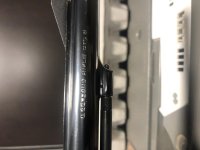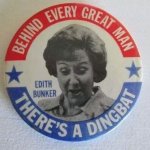You are using an out of date browser. It may not display this or other websites correctly.
You should upgrade or use an alternative browser.
You should upgrade or use an alternative browser.
What’s this stamp? M1953
- Thread starter Tycer
- Start date
Register to hide this ad
In printing, it's called a dingbat. S&W used a number of different symbols over the years. My favorite is the one used on the Highway Patrolman.
They're primarily ornamental decorations, but they do help provide even depth to the die stamp and reduce the chance of broken characters.
Nice gun! That's a Model of 1953 .22/32 Kit Gun, made before about 1955-56. It's an I frame, but will take later RB J frame grips.
They're primarily ornamental decorations, but they do help provide even depth to the die stamp and reduce the chance of broken characters.
Nice gun! That's a Model of 1953 .22/32 Kit Gun, made before about 1955-56. It's an I frame, but will take later RB J frame grips.
Last edited:
Alk8944
US Veteran
What s&wchad said is correct. The device is a modified Maltese Cross. These appear on every S&W revolver since at least the 1890s.
More about DINGBATS:
i.e., Typographical Ornaments. Many wonder what the little iron cross-like marks are at the beginning and end of the cartridge and/or patent date roll mark on the barrel. Typographical ornamentation of many types was used as "feet", in printer vernacular, back in the day to begin and end text to help align printing. The use by S&W, of their ornament choices we're so familiar with, began in the 19th century and used thru and after WW II on many models. It was used on S&W firearms as far back as at least their DA Top-Break in my observation. And long preceded when the use of the 'dingbat' moniker became generic. S&W's use is very inconsistent. Although one consistency seems to be, they aren't reported to be observed on the Smith & Wesson name barrel stamp.
The most commonly two styles observed, (doesn't mean there aren't others), is the 3 legged and occasionally four legged design. Those with four legs are the most similar to the Maltese Cross but the two vertical legs are thicker and sometimes than the horizontal legs. The rectangular dingbat style with one open side is actually the usual 3 legged style but just deeply stamped. Different design versions can be observed on the same barrel.
More dingbat styles used on Smiths here: Dingbat
My 44 Triple Locks have 4 legged dingbats on the address/patent dates stamping and 3 legged on the cartridge stamp. The little M frame .22 has them on both ends of the cartridge roll stamp.

Photo credit: serafinglez
Post #4 here: 32 LONG CTG HELP ID.
Colt New Police w/Maltese Crosses post #90 here: http://smith-wessonforum.com/s-w-ha...l-1926-question-2.html?posted=1#post140112072
The term"dingbat" as used for myriad ornamental type designs didn't begin until around 1921 and is almost certainly based on the "dingbat" meaning of "a nameless object."
When applied to a person "dingbat" came from "dingus" or "dingy" added to "batty" to be used for "a silly, eccentric, somewhat dim person", i.e., of Archie Bunker fame.
i.e., Typographical Ornaments. Many wonder what the little iron cross-like marks are at the beginning and end of the cartridge and/or patent date roll mark on the barrel. Typographical ornamentation of many types was used as "feet", in printer vernacular, back in the day to begin and end text to help align printing. The use by S&W, of their ornament choices we're so familiar with, began in the 19th century and used thru and after WW II on many models. It was used on S&W firearms as far back as at least their DA Top-Break in my observation. And long preceded when the use of the 'dingbat' moniker became generic. S&W's use is very inconsistent. Although one consistency seems to be, they aren't reported to be observed on the Smith & Wesson name barrel stamp.
The most commonly two styles observed, (doesn't mean there aren't others), is the 3 legged and occasionally four legged design. Those with four legs are the most similar to the Maltese Cross but the two vertical legs are thicker and sometimes than the horizontal legs. The rectangular dingbat style with one open side is actually the usual 3 legged style but just deeply stamped. Different design versions can be observed on the same barrel.
More dingbat styles used on Smiths here: Dingbat
My 44 Triple Locks have 4 legged dingbats on the address/patent dates stamping and 3 legged on the cartridge stamp. The little M frame .22 has them on both ends of the cartridge roll stamp.
Photo credit: serafinglez
Post #4 here: 32 LONG CTG HELP ID.
Colt New Police w/Maltese Crosses post #90 here: http://smith-wessonforum.com/s-w-ha...l-1926-question-2.html?posted=1#post140112072
The term"dingbat" as used for myriad ornamental type designs didn't begin until around 1921 and is almost certainly based on the "dingbat" meaning of "a nameless object."
When applied to a person "dingbat" came from "dingus" or "dingy" added to "batty" to be used for "a silly, eccentric, somewhat dim person", i.e., of Archie Bunker fame.
Stifle yerself, Edith!
Similar threads
- Replies
- 3
- Views
- 263
- Replies
- 5
- Views
- 295




